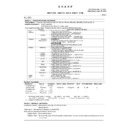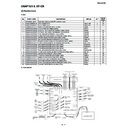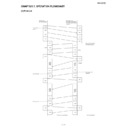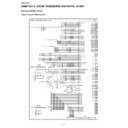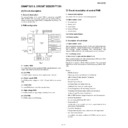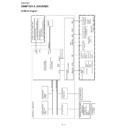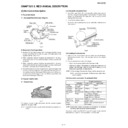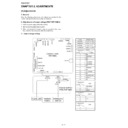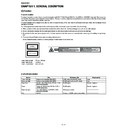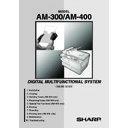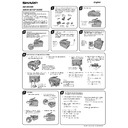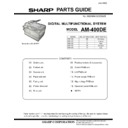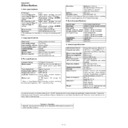Read Sharp AM-400 (serv.man14) Regulatory Data online
S H A R P
Date Revised:Mar. 15. 2005
Date Issued : Sep. 16. 2004
MATERIAL SAFETY DATA SHEET (
1/4
)
M S DS
No. B-
1021
Section 1. Product and Company Identification
Product Name : Toner Cartridge of AM-900, AM-700, AM-300, AM-400, AM-30DC, AM-90ND, DUNT-29LDXH01
Supplier Identification : Sharp Corporation
22-22 Nagaike-cho, Abeno-ku, Osaka, Japan
Local suppliers are listed below. Please contact the nearest supplier for additional information.
Local suppliers are listed below. Please contact the nearest supplier for additional information.
(Country)
(Name and Telephone Number)
U.S.A.
Sharp Electronics Corporation
Telephone number for information: 1-800-237-4277
Emergency telephone number : 1-800-255-3924
Telephone number for information: 1-800-237-4277
Emergency telephone number : 1-800-255-3924
North
America
America
Canada
Sharp Electronics of Canada Ltd.
Telephone number for information : 905-890-2100
Emergency telephone number : 1-800-255-3924
Telephone number for information : 905-890-2100
Emergency telephone number : 1-800-255-3924
Oceania
Australia
New Zealand
AUSTRALIA
SHARP CORPORATION OF AUSTRALIA PTY. LTD.:
(Phone) 02-9830-4600, 1800 807 820
NEW ZEALAND
SHARP CORPORATION OF NEW ZEALAND LTD.:
(Phone) 09-634-2059
SHARP CORPORATION OF AUSTRALIA PTY. LTD.:
(Phone) 02-9830-4600, 1800 807 820
NEW ZEALAND
SHARP CORPORATION OF NEW ZEALAND LTD.:
(Phone) 09-634-2059
Germany
Sharp Electronics (Europe) GMBH
Sonninstrasse 3, 20097 Hamburg
Telephone number to access MSDS : 040-2376-2185
For more information : 040-2376-2613
Sonninstrasse 3, 20097 Hamburg
Telephone number to access MSDS : 040-2376-2185
For more information : 040-2376-2613
United
Kingdom
Sharp Electronics (U. K.) Ltd.
Telephone number for information : 01923-474013
France
Sharp Electronics France S.A.
Telephone number for information : 01-49-90-34-00
Telephone number for information : 01-49-90-34-00
Austria
Sharp Electronics GMBH
Telephone number for information : 01-727-19-0
Telephone number for information : 01-727-19-0
Italy
Sharp Electronics (Italy) S.P.A.
Telephone number for information : 02895951
Telephone number for information : 02895951
Spain
Sharp Electronics (Espana) S.A.
Telephone number for information : 93-581-97-00
Telephone number for information : 93-581-97-00
Netherlands
Sharp Electronics Benelux B.V.
Telephone number for information : 30-6359500
Telephone number for information : 30-6359500
Sweden
Sharp Electronics Nordic AB
Telephone number for information : 08-634-36-00
Telephone number for information : 08-634-36-00
Europe
Switzerland
Sharp Electronics(Schweiz)AG
Telephone number for information : 01-846-6111
Telephone number for information : 01-846-6111
Middle
East
East
U.A.E.
Sharp Middle East FZE
P.O.Box 17115 Jebel Ali, Dubai
Telephone number for information : 04-815311
P.O.Box 17115 Jebel Ali, Dubai
Telephone number for information : 04-815311
Section 2. Ingredients
Ingredients
Ingredients
Cas No.
Proportion OSHA Z-Tables ACGIH TLV
IARC
DFG-MAK(GER) Other Limits
Polyester resin
+++
80-90%
- - -
-
-
Carbon black 1333-86-4 1-10
%
3.5mg/m3 3.5mg/m3 2B III 3B ++
Polyolefin wax +++
1-10
%
- - -
-
-
Magnetite 1317-61-9 1-10%
- - -
- -
Amorphous silica 7631-86-9 < 1 %
++ : Worksafe-TWA(Austl) : 3 mg/m3, NTP(USA) : Not listed, EEC-No : 215-609-9,
Symbol (EC) : Not listed, R-Phrase (EC) : Not listed, California Proposition 65 : Listed
+++ : Supplier’s confidential information
Section 3. Hazardous Identification
Section 3. Hazardous Identification
Emergency Overview : Black powder (mean dia. Is 5-15im by volume).
Almost odorless.
Classification : Not classified as dangerous. (1999/45/EC)
Most Important Hazards and Effects of the Products
Ingestion Effect : None currently known.
Inhalation Effect : None currently known. Minimal respiratory tract irritation may occur as with exprosure to large amount of any
non-toxic dust.
S H A R P
Date Revised:Mar. 15. 2005
Date Issued : Sep. 16. 2004
MATERIAL SAFETY DATA SHEET (
2/4
)
M S DS
No. B-
1021
Eye Effect : None currently known.
Skin Effect : None currently known.
Chronic Effects : Prolonged inhalation of excessive dusts may cause lung damage. Use of this product, as intended, dose not result
in inhalation of excessive dust.
Environment Hazards : No data are available on the adverse effects of this product on the environment.
Specific Hazards : Dust explosion (like most finely divided organic powders)
Section 4. First-Aid Measures
Ingestion: Wash out mouth with water. Drink one or two glasses of water. If symptoms occur, get medical attention.
Inhalation: Move victim to fresh air immediately. If symptoms occur, get medical attention.
Eye Contact: Immediately flush eyes with plenty of water for 15 minutes. If symptoms occur, get medical attention.
Skin Contact: Wash with water and mild soap.
Section 5. Fire-Fighting Measures
Suitable Extinguishing Media: CO2, water spray, foam and dry chemical
Extinguishing Media to Avoid: Full water jet
Fire and Explosion Hazards: If dispersed in air, like most finely divided organic powders, may form an explosive mixture.
Protection of Firefighters: Use self-contained breathing apparatus (SCBA).
Section 6. Accidental Release Measures
Personal Precautions: None
Environmental Precautions: None
Methods for Cleaning Up: Wear personal protective equipment (See Section 8). Cacuum or sweep material and place in a bag and hold
for waste disposal. Use vacuum equipped with High Efficiency Particulate Air (HEPA) filter. Vacuum should
be electrically bonded and grounded to dispel static electricity. To avoid dust generation, do not sweep dry.
Section 7. Handling and Storage
Handling
Technical Measures: None
Precautions: Do not breathe dust. Avoid contact with eyes.
Safe Handling Advice: Try not to disperse the particulates.
Storage
Technical Measures: None
Storage Conditions: Keep container closed. Store in a cool and dry place. Keep out of reach of children.
Incompatible Products: None
Section 8. Exposure Control/Personal Protection
Engineering Measures
Ventilation: None required with intended use.
Control Parameters(As total dust)
OSHA-PEL(USA): 15mg/m3 ACGIH-TLV(USA): 10mg/m3 DFG-MAK(GER): 6mg/m3 Worksafe-TWA(Austl.): 10mg/m3
Personal Protective Equipment
Personal Protective Equipment
Not required under normal conditions. For use other than in normal operating procedures (such as in the event of large spill),
goggles and respirators may be required.
Hygiene Measures: Wash hands after handling.
S H A R P
Date Revised:Mar. 15. 2005
Date Issued : Sep. 16. 2004
MATERIAL SAFETY DATA SHEET (
3/4
)
M S DS
No. B-
1021
Section 9. Physical and Chemical Properties
Appearance
Physical State:
Solid
Form: Powder (mean dia. Is 5 – 15 um by volume)
Odor:
Almost odorless
Explosion Properties:
No data available
Boiling Point:
Not applicable
Solubility in water:
Insoluble in water.
Melting Point(°C):
Around 125C (275F) (Softing Point)
Color:
Black
Ignition Temperature(°C):
400 *
Specific Gravity :
1.2 *
Flash Point:
Not applicable
Vapor Pressure:
Not applicable
pH:
Not applicable
Partition Coefficient, n-Octanol/Water:
Not applicable
Section 10. Stability and Reactivity
Stability: Stable except above 200C (392F).
Hazardous Reactions: Dust explosion, like most finely divided organic powders.
Conditions to avoid: Electric discharge, throwing into fire.
Materials to Avoid: Oxidizing materials.
Hazardous Decomposition Products: CO, CO2, and smoke.
Hazardous Polymerization : Will not occur.
Section 11. Toxicological Information
Health Effects from Exposure: No symptoms expected with intended use.
Toxicological Data
Acute Toxicity:
Ingestion(oral), LD50(mg/kg) : >2000 (Rat) *
Dermal, LD50(mg/kg) : No data available
Inhalation, LD50(mg/l) : >1.93 (Rat, 4hour) *
(This was the highest attainable concentration.)
Eye irritation : Slight conjunctival irritation (Rabbit) *
Skin irritation : Non irritant (Rabbit) *
Sensitizer : Non sensitizer (Guinea pig)
Local Effects : See Chronic Toxicity or Long term Toxicity
Chronic Toxicity or Long term Toxicity :
In a two-year inhalation study of chronic toxicity and carcinogenicity using a typical toner in rats, there were no lung changes
at all in the lowest exposure level (1 mg/m3), the most relevant level to potential human exposures. A minimal to mild degree
of fibrosis was noted in 22% of the animals at the middle exposure level (4 mg/m3), and a mild to moderate degree of fibrosis
was observed in 92 % of the rats at the highest exposure level (16mg/m3). The lung changes observed in the higher exposure
groups are interpreted in term of “lung overloading”, a series of generic responses to the presence of large quantities of
respirable, insoluble and relatively benign dusts retained for extended time periods in the lungs. Lung tumor frequency was
unchanged among rats exposed to toner at the three exposure levels, and for air-only control rats.
Carcinogenicity
IARC Monographs: Not listed
NTP(USA): Not listed
OSHA Regulated(USA): Not listed
In 1996 the IARC reevaluated carbon black as a Group 2B carcinogen (possible human carcinogen). This
evaluation is given to Carbon Black for which there is inadequate human evidence, but sufficient animal
evidence. The latter is based upon the development of lung tumors in rats receiving chronic inhalation
exposures to free carbon black at levels that induce particle overload of the lung.
Studies performed in animal models other than rats have not demonstrated an association between carbon
black and lung tumors. Moreover, a two-year cancer bioassay using a typical toner preparation containing
S H A R P
Date Revised:Mar. 15. 2005
Date Issued : Sep. 16. 2004
MATERIAL SAFETY DATA SHEET (
4/4
)
M S DS
No. B-
1021
carbon black demonstrated no association between toner exposure and tumor development in rats.
Mutagenicity : Negative * (AMES test)
( * = Based on data for other products with similar ingredients)
Section 12. Ecological Information
No data are available on the adverse effects of this material on the environment.
Ecotoxicity : No data available
Mobility : No data available
Persistence and degradability : No data available
Bioaccumulative potential : No data available
Section 13. Disposal Consideration
When disposing of the waste or recovered material, consult federal, state and/or local regulations for the proper disposal method.
Section 14. Transport Information
Information on Code and Classifications According to International Regulations
UN Classification: None
Section 15. Regulatory Information
US Information
Information on the label: Not required
TSCA(Toxic Substances Control Act):
All chemical substances in this product comply with all applicable rules or order under TSCA.
California Proposition 65:
Ingredient carbon black subject to California Proposition 65 is bound in polymer-matrices so that warnings are not required.
EU Information
Information on the label (1999/45/EC) and 67/548/EEC) : Not required
Article 14 (2.1) of Directive 1999/45/EC is not applicable to this product.
Section 16. Other Information
HMIS Rating: The National Paint and Coating Association(USA): Health: 1 Flammability: 1 Reactivity: 0
Recommended Uses: Toner for Electrophotographic Equipment
Explanation of term : IARC 2B means “possible human carcinogen”.
Restrictions: This information relates only to the specific material designated as supplied by the manufacturer. This information is
supplied to us by the manufacturer and Sharp offers no warranties as to its accuracy and accepts no responsibilities
for any typographical errors which may appear on these sheets. It is the responsibility of the user to determine the
suitability of this product for each particular use.
Revision Information :
2004/Sep/16 Not applicable in this time due to new issue.
2005/Mar/15 Addition of model name “AM-30DC”, “AM-300”, “AM-400”

